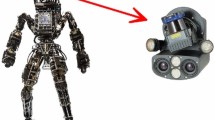Abstract
A simple pendulum is considered as a swing model. The distance between the suspension point of the swing and the center of mass of the person standing on it acts as a limited control action, and the swing with a person on it is a system with one degree of freedom. In the form of feedback, an optimal control is constructed, under which the most rapid increase in the oscillation amplitude occurs. If the coefficient of viscous friction at the suspension point of the swing is large enough, then under this control the swing asymptotically enters the steady-state oscillation mode with a constant amplitude. If the coefficient of friction is rather small, then the oscillations of the swing turn into rotation around the suspension point. A more realistic swing model is also considered with two degrees of freedom. In this model, the control is a force that moves the center of mass of a person along the swing.







Similar content being viewed by others
REFERENCES
K. Magnus, Eine Einfuhrung in die theoretische Behandlung von Schwingungsproblemen (J. Teubner, Stuttgart, 1976).
F. L. Chernous’ko, L. D. Akulenko, and B. N. Sokolov, Control of Oscillations (Nauka, Moscow, 1980) [in Russian].
S. L. Chechurin, Parametric Oscillations and Stability of Periodic Motion (LGU, Leningrad, 1983) [in Russian].
L. D. Akulenko, Asymptotic Methods of Optimal Control (Nauka, Moscow, 1987) [in Russian].
S. M. Curry, “How children swing,” Am. J. Phys. 44, 924–926 (1976).
W. B. Case, “The pumping of a swing from the standing position,” Am. J. Phys. 64, 215–220 (1996).
A. P. Seiranyan, “The swing: Parametric resonance,” J. Appl. Math. Mech. 68, 757–764 (2004).
A. A. Zevin and L. A. Filonenko, “A qualitative investigation of the oscillations of a pendulum with a periodically varying length and a mathematical model of a swing,” J. Appl. Math. Mech. 71, 892–904 (2007).
S. Wirkus, R. Rand, and A. Ruina, “How to pump a swing,” College Math. J. 29, 266–275 (1998).
E. K. Lavrovskii and A. M. Formal’skii, “Optimal control of swing and swing braking,” Prikl. Mat. Mekh. 57, 92–101 (1993).
A. M. Formal’skii, Motion Control of Unstable Objects (Nauka, Moscow, 2012) [in Russian].
A. M. Formalskii, Stabilisation and Motion Control of Unstable Objects (Walter de Gruyter, Berlin, 2015).
W. B. Case and M. F. Swanson, “The pumping of a swing from the seated position,” Am. J. Phys. 58, 463–467 (1990).
L. A. Klimina and A. M. Formalskii, “Three-link mechanism as a model of a person on a swing,” J. Comput. Syst. Sci. Int. 59, 728 (2020).
Yu. F. Golubev, “Method for optimal control of mechanical systems oscillations,” KIAM Preprint No. 33 (Keldysh Inst. Appl. Math., Moscow, 2021), pp. 1–37.
Yu. F. Golubev, “Optimal control for nonlinear oscillations of natural mechanical systems,” Lobachevskii J. Math. 42, 2596–2607 (2021).
Y.F. Golubev, “Optimization of Oscillations of Mechanical Systems,” Dokl. Math. 105, 45–49 (2022).
V. V. Aleksandrov and V. N. Zhermolenko, “On the absolute stability of second-order systems,” Vestn. Mosk. Univ., Mat., Mekh., No. 5, 102–108 (1972).
J. A. C. Wismans, F. Veldpaus, J. Janssen, A. Huson, and P. Struben, “A three-dimensional mathematical model of the knee-joint,” J. Biomech. 13, 677–685 (1980).
Author information
Authors and Affiliations
Corresponding authors
Ethics declarations
The authors declare that they have no conflicts interest.
Rights and permissions
About this article
Cite this article
Klimina, L.A., Formalskii, A.M. On the Optimal Swinging of a Swing by a Person Standing on It. J. Comput. Syst. Sci. Int. 61, 944–953 (2022). https://doi.org/10.1134/S1064230722060119
Received:
Revised:
Accepted:
Published:
Issue Date:
DOI: https://doi.org/10.1134/S1064230722060119




